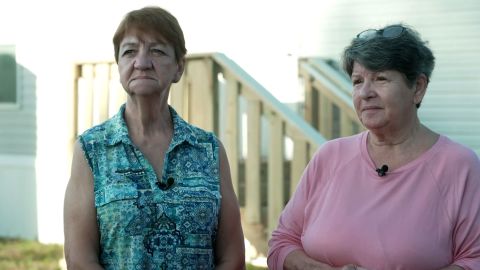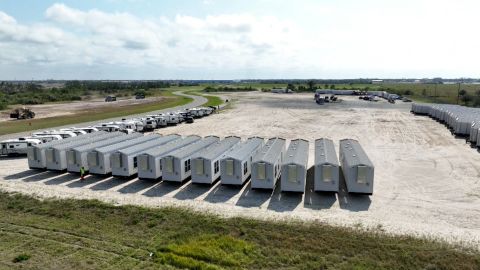Fort Myers, Florida
CNN
—
In the shadow of Lee McCall’s crumbled home sits an old RV and two tents that are now housing her family.
The house, located in St. James City, is still rotting after Hurricane Ian pounded Southwest Florida in September, flooding thousands of homes, including theirs. The small community outside Fort Myers is still marred by storm wreckage on most streets.
McCall, 86, is staying in the RV with her husband. Her two daughters are living in one tent and two grandkids in the other.
“At my age, what am I going to do?” McCall said.
She says they’re still waiting for their insurance payout and don’t have the money to rebuild. But they spent a month living in their cars, so this setup, she says, feels like heaven.
“Thank God for what you get. And I do everyday,” she said.
More than four months after Hurricane Ian, many homeowners in the Fort Myers area are still homeless, some living in difficult or even dangerous conditions.
Nicole Williams moved back into her damaged home in Bokeelia last month even though contractors have told her it’s beyond repair. Her rental assistance ran out, she says, and she had nowhere else to go.
“The mold situation in there is terrible. I can barely breathe,” she said. “I don’t have a choice… It’s here or on the street.”
Bobby Mann and his wife are in the early stages of rebuilding their house in Flamingo Bay. After staying with friends for weeks, he and his wife have started sleeping in the back of their car or in two small chairs inside their hollowed home.
“It breaks you, physically, emotionally,” Mann said. “You’re drained.”
In pictures: Hurricane Ian slams the Southeast
Sonny Reeves, a 73-year-old retired Marine, took out a loan with his wife to buy an RV. He’s one of many residents in the area staying in similar vehicles on or near their property. But Reeves can barely fit his walker inside the camper. It’s been a struggle for the couple.
“We’ve been together 50 years, and this has been the most stressful thing we’ve had to go through,” he said.
Reeves is especially frustrated by the spray paint marks on his driveway. They indicate he’s been approved by FEMA for a free temporary trailer to live in while he rebuilds his home. But he says he’s been waiting for it since October.
“They know we need a need, so can’t they answer it?” he said. “Maybe I’m not calling the right person.”
CNN spoke with many survivors, few of whom have insurance, who say they’ve been approved by FEMA for temporary housing units, but they have no idea when they’re coming.
Nearly 3,000 households have been approved for direct housing since Hurricane Ian, but as of last week, FEMA says only 225 have received it. It’s become a heated issue in parts of Lee County.
Brian Hamman, an elected Republican and chairman of the Lee County Board of County Commissioners, says FEMA assistance has been critical to the area’s recovery but claims the agency has dropped the ball on direct housing.
“Where’s the sense of urgency? Why is nobody helping these people?” Hamman said. “They were approved, many of them, and they didn’t see anything actually materialize out of that. So, we’re trying our best to fight for it.”
Hamman blames what he sees as red tape at the federal level.
It took until January for FEMA to bypass a policy that bars it from putting trailers in a flood zone, the agency says. Eventually the agency created a waiver for Hurricane Ian survivors because most of them live in one.
“FEMA created all these rules, and all these processes and all these things, the hoops that people have to jump through to get their assistance,” Hamman said. “When you’re in a disaster, you need help right away. You don’t need help three months from now.”
But FEMA defends their response. The agency has provided more than $970 million dollars in individual aid, including assistance with rent and repairs for tens of thousands of households.
“This is that final step in recovery,” Keith Denning, a FEMA Deputy Federal Coordinating Officer helping to lead the recovery, said of their direct housing rollout.
The agency admits that the process to craft that flood zone waiver delayed the rollout of many housing units, but tells CNN that since that January change more units are going out every day. They also note that placing the trailers is a complex process that can sometimes be halted for reasons beyond their control, like issues with utilities.
A lack of affordable housing has fueled higher demand. The average rent cost in the Fort Myers area is up more than 50% in two years, from $1308 per month to $2086, according to data from Zillow. And far fewer units are available because of storm damage.
“We’re working faster. We’re ramping up the direct housing operation,” Denning said. “We didn’t have any issues with red tape. It was our own regulations that we needed to interpret and work with local officials to be able to place trailers.”
But even some of the recipients of those units are still struggling to get settled.
FEMA delivered a mobile unit to RoseAnn Cutler and Paula Colose, two widowed sisters in their 70s, on January 4. But more than a month later, the two are still locked out of it because the water isn’t hooked up. And until the unit passes inspection, they’re not allowed inside, per FEMA policy.
“We’re so frustrated. We’ve got everything ready to go,” Colose said.

They’re still living in their damaged home, running an extension cord from their neighbor’s house to power appliances and hauling water with a wheelbarrow to boil for showers. They don’t know when they’ll be able to access the trailer.
“It can, in our process, take several weeks once the trailer is placed for all those things to happen,” FEMA’s Denning said, adding that such a long delay is rare.

FEMA expects the housing rollout to continue picking up steam in the weeks ahead, delivering trailers and mobile homes to private properties and constructing some group sites. The agency says it should finish most of that work by mid-March.
But some residents are skeptical.
“I’ll believe it when I see it,” Bobby Mann said, looking at the spray paint marks in his driveway. “Because it’s hard to believe anything at this point.”